I find notes to myself everywhere – jotted on scraps of paper, tucked in folders and books, scribbled in the pages of other documents, inside printed-out email messages – reminders of incidents or ideas, quick insights or future dreams. Proliferating for decades, they are extensions of my memory, or at least a source for recovering pieces of it. Each note captures something I’ve found intriguing, worth attention in the moment and sometimes worth pursuing further. I’ve imagined that each note leaves a dent in my memory. Recovering it deepens the dent, gives me a chance to consider its contents again.
Each small dent is different from the next. Recently it occurred to me that all these dents may be making a pattern, like the elaborate designs on old silver pitchers or the patterns in pressed tin ceilings or the random dings in a much-loved sauce pan. But until now I hadn’t consciously tried to decipher the design.
A month or so ago, my energy for writing got sluggish. It was hard to start anything, even though my list of ideas was long. I decided to get out of town to see if a change in surroundings would help. I also decided that in this short chunk of time, I would avoid trying to begin anything new and big. Instead, I gathered up some of the notes I’ve kept on scraps, those “dents” in my memory, polished them a bit, and considered how they might fit together.
A collection of these short pieces follows here.
![]()
Drawing on snow
February 2019 was Seattle’s snowiest month in 50 years – more than 20 inches fell during the month. One morning, sitting in my bright second-floor corner apartment after the month’s first big storm, I got a good view of neighborhood comings and goings and of the weather and sidewalk conditions at the intersection below. I admired the snow, layered up smoothly on the tops of bushes along the sidewalk. Though it came roaring back later that week, on this day the snow had begun to melt. The sun was out, the street was wet, and the sidewalks were slushy and icy.
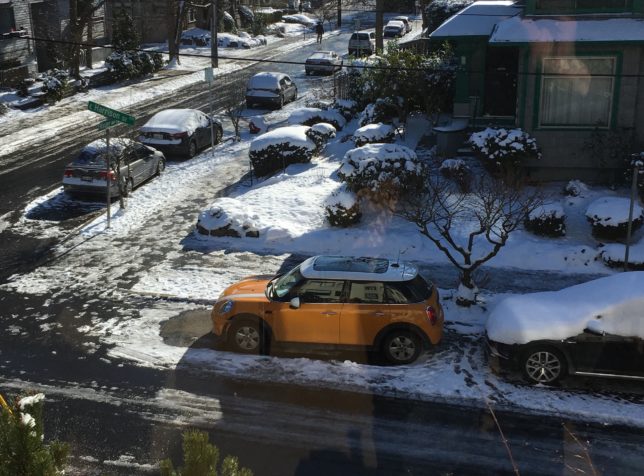
As I watched, wondering how long the snow would last, an older woman with a cane, in a pink coat, walked toward my building. As she approached the corner, she turned toward one of the flat snow-topped bushes, lifted her cane, and wrote or drew something in the snow on top. She admired it briefly and walked on.
The bush faced away from my window, just out of sight. I was sorry I couldn’t see what she had written. Eventually, my curiosity got me on my feet. I put shoes on, grabbed a coat, and went out to see what the neighborhood walker had drawn.
When I saw it, I thought, of course! What would anyone of any age draw with just a few strokes? Her cane-drawn heart lasted three days until the next big storm came through.
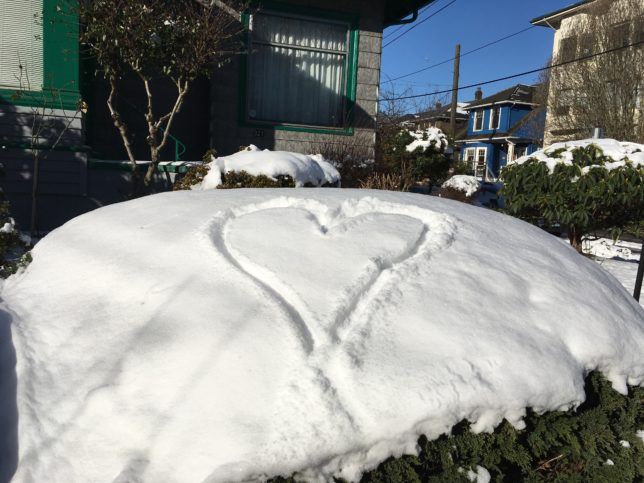
Instant community and a lime
One evening after a busy and fragmented day, I enjoyed a light but just-right meal at a neighborhood bar and bistro owned by a friend. While I sat by the front window eating, a colorfully dressed, 25-year-old woman walked out the door past me. Standing with a cigarette, she initiated, in a way that seemed effortless, a street-side conversation with a gray-bearded man sitting on a motorcycle he’d just parked. They were soon joined by a young black man pulling behind him a loosely-full garbage bag. With laughs and small gestures, all three seemed to be having a good time and eventually headed off in separate directions. From where I was, only a few feet away but on the other side of the glass, they were like players in a silent movie. What an amazing instant community, I thought.
Apparently, the young woman felt I’d been a friendly, if mute, part of their conversation, and, before returning to the bar, came over to tell me about herself, which is how I know her age. A little later, as she left the cafe, she came back and gave me a lime.
A lime? I learned afterward that she’d bought it from the bartender. Surprised, I thanked her. It’s the only time I’ve been given a lime. Her gift, and the easy openness she carried with her, were soothing – a magical antidote to an otherwise hectic day.
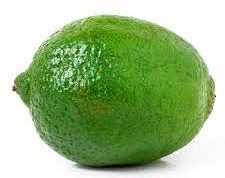
What I love so often falls in between
In 2005 a space in Seattle’s new City Hall was given my name. The Anne Focke Gallery consists of the lower-level elevator lobby and a stepped-back space that becomes a corridor to the community meeting rooms. At least half-a-dozen rooms in City Hall were dedicated to specific people that day. Unlike many “naming rights” these days, naming these rooms had nothing to do with financial support, and I was one of just two who were still alive. I felt honored. I was also on the program to say a few words at the dedication ceremony. As often happens, I carefully planned my remarks, but when my turn came and I faced the crowd, my mind went blank. I spoke extemporaneously, forgetting most of what I’d prepared. This is my chance to share some of what I’d written in advance.
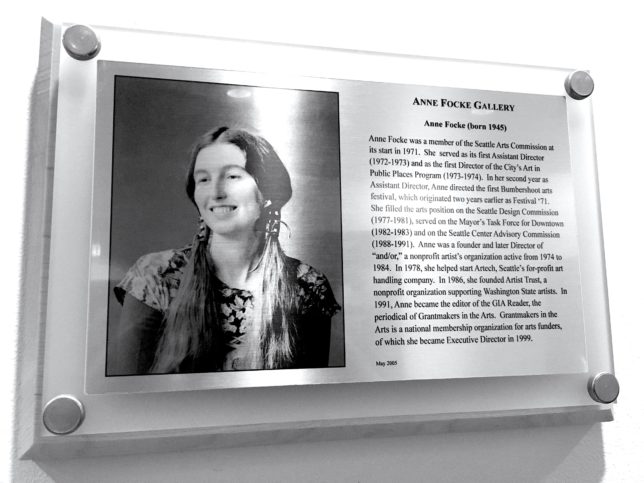
May 14, 2005
Many thanks to the City for giving this space my name. I’m truly honored.
The space seems just right.
It’s an odd little space
between things
not exactly a room
not exactly a corridor
not exactly square.
It’s a space that falls between other spaces.
It suits me. The art and work I love so often falls in between.
An etched wall plaque suggests permanence. But this space is the passageway to community rooms. It’s also an intersection as people come and go from the elevator. This room will always be full of energy as the art on the walls, the people passing through, and the communities they care about change. Their inevitable shifts and turns will fill this space with possibility.
My hope for this space is that it can also stand for:
Paying attention to what doesn’t seem to fit.
Making room for something new.
Putting trust in artists – their imagination, their ideas, their work.
Giving young people real responsibility.
Celebrating our contemporaries, people who are alive in the world.
So many of you in the room contribute to making our city what it is. Much of what the City remembers me for I had the opportunity to do when I was in my 20s. Perhaps every five years or so the space should be renamed for someone else who made a difference when they were young.
Finally, I hope this gallery can stand for the qualities of luck, serendipity, and openness to the unexpected. So much of what I value requires what Jane Jacobs called “drift,” a kind of work defined not by “practical utility,” but by play, curiosity, and aesthetic investigation – work that often falls in between.
2019 coda: Increasingly we live in a black and white, either/or, in or out world. Can we discover the value and beauty of grays, the possibility of and’s, the creativity and energy in between?
Knowing a little about a lot of things
I’m not a specialist.
Self-analyst that I am, I’ve known for years that I’m no specialist. Recently I ran across a crinkled, brown paper napkin where, perhaps five years ago, I’d scribbled a list of observations about this character trait. I’d probably forgotten to bring notepaper along to the coffee shop where I’d been sitting when the need came to jot the list down. After reflecting on the words for a moment, I probably just absent-mindedly tucked the napkin into whatever I’d brought along to read, and it took a while to resurface. The deciphered handwriting says that I…
Know a little about a lot of things.
Know a lot about how to live and move through the world knowing a little about a lot of things.
Know how to do a lot while knowing a little about a lot of things.
Know a lot about how to do a lot while knowing a little about a lot of things.
“Knowing a little about a lot of things” is not something that shines on a professional resume or in a job interview. But it seems a fine, even useful way to live, love, and work. And I’ve managed to get a lot done even without a specialty.
An experience as a pre-teen gave me an image I continue to value. When I was about twelve, a difficult day at school had left me feeling rejected and desperately insecure. It might have been the day I was called a “leech” by girlfriends and banished from the lunch table. When I got home, I went out behind our house and took my anger and frustration out by knocking rocks into the valley with my baseball bat.
As the high emotion gradually seeped away, I wondered how I could go on, how I could get past the bad feeling I had. I got help from my love of geometric forms – a love probably fostered by my physicist father – and imagined two choices. I could think of myself as an upside-down pyramid with everything balanced on one point, meaning that if I were knocked off that point (as I’d felt that day), the whole structure would come tumbling down. Or, I could think of myself as a complicated polyhedron with many points, meaning that if the point I balanced on was disturbed, the structure would turn only slightly to another point and I would only fall a little. I couldn’t be completely knocked down.
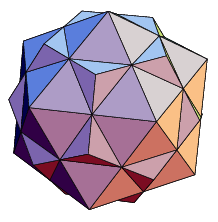
The mental picture of having many facets and many points of balance remains a valuable piece of my self-image. It affects my approach to emotional challenges and it gives me a boost when I feel insecure about my lack of a “specialty.” All those facets and points on the polyhedron in my mind help me remember the value of knowing many little things, rather than just one big thing. Getting work done this way means thinking and moving horizontally rather than vertically, learning and making connections broadly rather than specializing deeply, being able to move easily from one thing to the next.
Too much society?
Excerpt from an email response to David Mahler, December 5, 2009.
Yes, indeed, thanks. I am finding many ways to get walking into my life. I try to walk two to three miles a day, though it varies. I’ve had a personal tradition for the past four or five years of circumambulating Lake Union on Thanksgiving Day before the big meal. My aim is to stay as close to the water as possible. It’s a continuing treat. The weather definitely plays a role, and the terrain and landscape change a lot on the way around. Surprising phenomena and characters always show up. One year I passed the same couple twice and we realized we were each doing the same thing. We said, “See you next year!” though we haven’t.
This year I took a shortcut and ran into a wild-looking fellow on a little road that ran along a run-down complex of wooden buildings where I suspect he lived. As he chased pigeons away from the building, he muttered to me, “Too much society!” I smiled and scooted away, hoping I also wasn’t too much society. After I passed by, he shouted in my direction, “Hey!” I turned around and saw him give me a big thumbs-up, “Thanksgiving!”
Us and them
Once upon a time, we lived with convenient polarities – us and them, women and men, black and white, young and old, the in-group and the out-group. We now know better. We have so many ways to define gender, so many shades of human color, so many ways to be our many ages.
In truth, I move through the world inside many different groups, and outside many others, inside many varieties of “us” and outside many different “thems.” Sometimes us shifts and becomes them, or them transforms into us, or the boundaries become porous and I am neither or both at the same time.
In fact, my world is all mixed up and always shifting.
How is it that we’ve allowed ourselves to be defined by sharp divisions? We need our many small communities, but do they have to be at war with each other? How do we stop the warring without losing the community that we get from “us?”
Quiet in Port Townsend
In the Port Townsend home of friends during a self-made writing and thinking retreat.
Sitting alone trying to write, I’m distracted by the silence . . . though, in fact, it really isn’t “silent.” When I hold still, I hear the inside of my head, and then the sound of the keyboard when I start writing. Whatever noise there is, I make myself.
It’s startling. I can’t stop listening. The refrigerator is off, no car is crunching down the gravel street. It’s 9:30 pm. The birds are silent.
Ah, now I hear the hum of a small plane, far off, fading quickly. The soft hum-buzz in my brain keeps going. I wonder if someone with better hearing would hear more. But there . . . the refrigerator seems to be slowly gearing up, just one small step up in volume at first. A couple of tiny creaks from the house, probably cooling down from the day. And now the fan of the heating system kicks in. (It wasn’t the refrigerator after all.) The temperature has dropped low enough to trip the thermostat. The sound of the fan rises, first slowly . . . now with more oomph.
The silence has vanished.
Notes
The polyhedron in “Knowing a little about a lot of things” is actually a dodecahedron-icosahedron compound and the beautiful image comes from Wolfram MathWorld. You can find the graphic and a description of it at: http://mathworld.wolfram.com/Dodecahedron-IcosahedronCompound.html.
The photo in “In between” was taken in 2019 of a plaque created in 2005 which includes an etched photo taken in 1978.
![]()
I love the image of Memorable Dents! So expressive a term for the ways our minds crumble and re-form. No need for dent repair, it’s what gives these vehicles that carry us forward—our minds and bodies—our unique character. Thanks, Anne.
Richard
Fantastic
So glad you collected and saved these scraps!
They add up to a fascinating commentary- – a faceted self-portrait of a wide-Awake human.
Love
L
Anne- years ago I attended on of your events st your apartment with my old boss. Renny Pritikin.
I’m still on your email list, and sometimes I read your muses. They are delightful! Thank you!
What a nice memory, Annabelle. Thanks for writing!
I can’t quite read what appears appears on the plaque of your City Hall space. I would love to know what is written there. What an honor that is, indeed!! And what a lovely photograph of you as well.
Thanks, Nancy! The text is mostly a short bio, concentrating on various positions I held with the city. For a decade or two, I think I was the crazy young artist person who brought some age diversity to the table and, for the most part, could actually act like a grown-up in those situations. From time to time, I do the same thing now, just at the other end of life.